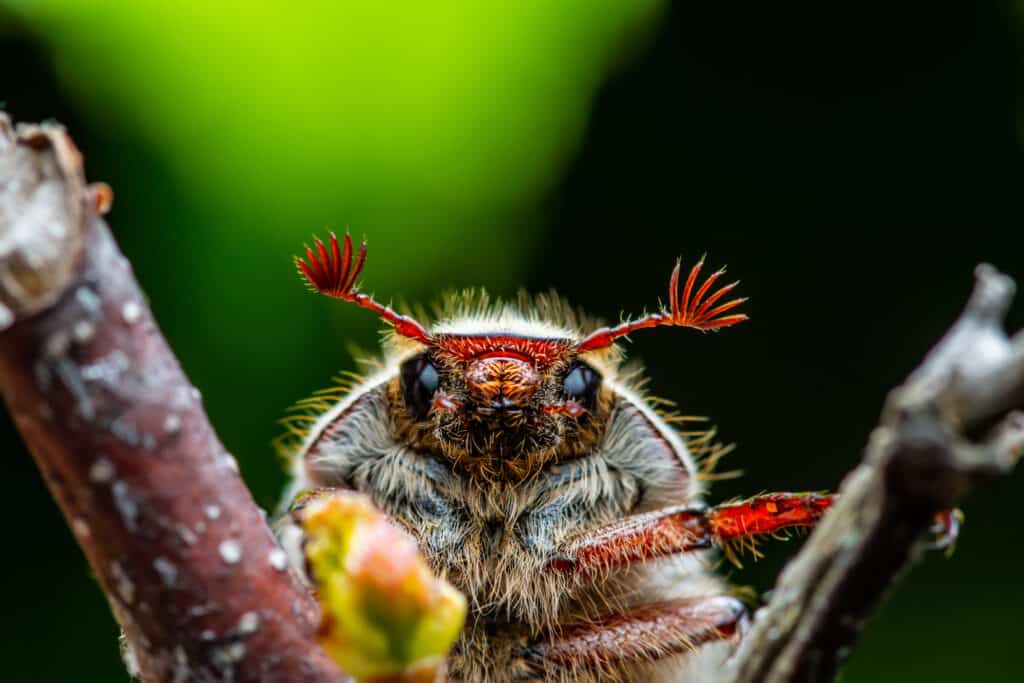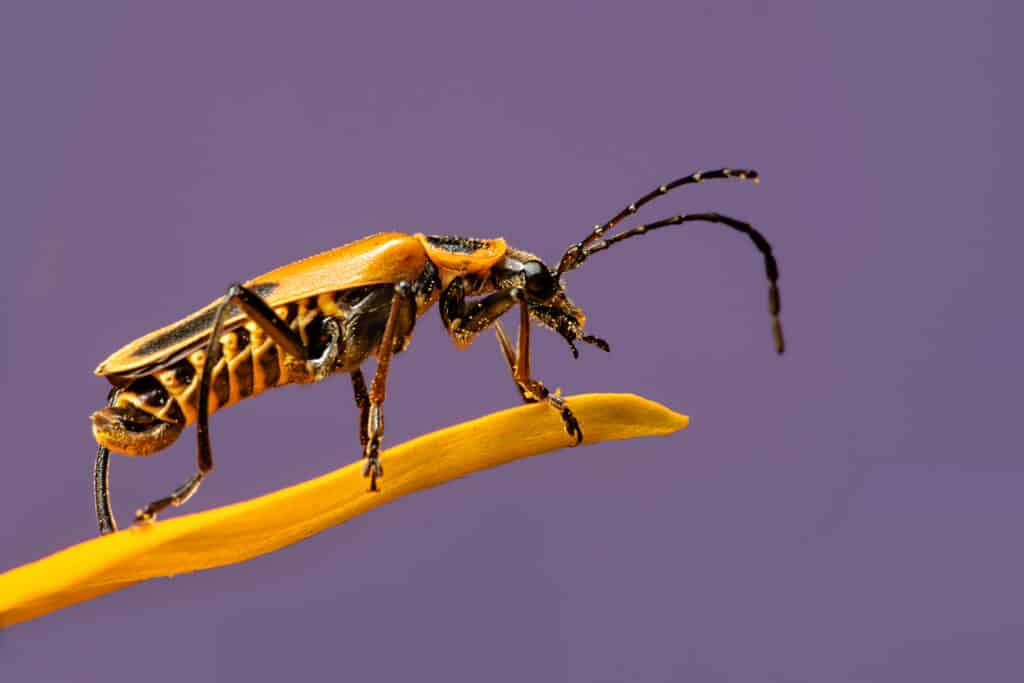Insects are a vast class of creatures that comprise beetles, butterflies, ants, bees, and more. It is estimated that there are more than 5.5 million species of insects. They are always all around us. Scientists believe that there are more than 10 quintillion, or 10 billion, insects alive on planet earth at any given moment.
What Makes an Insect, an Insect?

While many insect species have wings, some do not. If the species does have wings, they attach to the thorax.
©nechaevkon/Shutterstock.com
Insects are hexapods, meaning they have six legs. These legs are arranged along their body in three equal pairs. Their bodies have three segments:
- Head
- Thorax
- Lower abdomen
Their heads have antennae, two different types of jaws (one for crushing and one for chewing), and a lower lip called a labium that serves different functions in various insect species. For example, in bees, the labium helps the bee suck up nectar. Dragonflies use their long, flexible labium to snatch up prey.
While many insect species have wings, some do not. If the species does have wings, they attach to the thorax.
Where Do Insects Go in the Winter?
With such a large number of species, it only makes sense that insects have a wide variety of winter behavior.
Migration
Some insects migrate, or travel, to a different area for the winter. They typically journey to a place that is warmer and easier to survive the winter months. The downsides of migration for insects are that it can take a lot of energy, and in some insects, like monarch butterflies, a migration can take multiple generations.
Some insects also do a reverse migration. They stay in a warmer climate for winter and then migrate north to new food sources in the spring and summer.
Examples of insects that migrate include:
- Monarch butterflies: Some travel up to 3,000 miles from northern North America to Mexico for the winter.
- Black cutworms: They can travel more than 1,000 miles in two days.
- Pink spotted hawkmoth: They migrate from Central America to as far north as Maine.
Overwintering in Different Life Cycle Stages
Some insects stay right where they are for the winter, but they protect themselves by strategically timing their life cycle.
As Eggs
Some insects spend the winter in their egg form. They have developed hearty eggs that can withstand winter temperatures and weather.
Examples of insects that spend their winters in the egg stage include:
- Bagworms: They lay 300 or more eggs inside old “bags” or cocoons from the previous year’s bagworms to protect them from winter weather.
- Corn rootworms: They lay their eggs in the soil for the winter. When they hatch in spring, the larvae feed on corn plant roots.
- Praying mantis: This insect lays over 300 eggs in a sac to protect them for the winter, after eating its mate.
As Larvae
Other insects spend the winter right after the egg stage, in the larvae stage. Some of these bugs do this by living in makeshift shelters or burrowing under dead plant material. Others survive deep in soil or sand. Still, others have a special chemical in their blood called glycol that works as an antifreeze to keep larvae alive in the winter.
Examples of insects that spend the winter as larvae include:
- Woolly bear caterpillar: These larvae freeze solid in the winter but survive through antifreeze properties in their blood.
- Goldenrod gall fly: This bug produces three different types of antifreeze to survive cold icy winters.
- Dragonflies: Some species of dragonflies spend their larval stage in the winter underwater.
As Pupae
Some insects go through metamorphoses in a chrysalis as a way to survive the winter. The chrysalis often protects them from harsh winter weather, and many of these insects have antifreeze properties as they go through their changes in the pupa.
Some insects that spend the winter as a pupa include:
- Silkworms: These bugs spin their cocoon out of silk. In nature, they spend winter in these cocoons. In the silk production process, the cocoons are boiled, and the silkworms are often eaten.
- Cecropia moths: These moths, which are the largest moths native to North America, spend the winter in large cocoons and then come out in the first few weeks of spring.
- Swallowtail butterflies: Swallowtails that live in colder areas spend the winter in their pupal stage.
As Adults (Hibernation)
Some insects hibernate or go dormant for the winter in their adult stage. Many of these insects survive the cold by reducing the amount of water in their bodies and increasing the production of antifreeze chemicals. The one downfall is that the insects start to thaw out and emerge once temperatures warm up again, but if temperatures go back down, many species don’t easily go back into dormancy. So, fluctuating winter temperatures can harm certain insect populations.
Examples of insects that hibernate as adults include:
- Ants: These famously social insects don’t go into any kind of stasis mode, but they do fatten up in the spring and summer and hole up together in the winter, using their body heat for warmth and stores of body fat for nourishment.
- Ladybugs: These red and black bugs, which are often considered good luck, gather together by the thousands and spend winters hiding together in logs, under rocks, and inside man-made structures.
- Brown marmorated stink bug: This smelly bug hides in the eaves and chimneys of homes to hibernate, staying warm and dry.
Staying Active in the Winter

Some insects hibernate or go dormant for the winter in their adult stage.
©Muskoka Stock Photos/Shutterstock.com
In rare cases, insects remain active in the winter. In even rarer cases, these insects have their most active time in the colder months.
Insects that are active in the winter include:
- Springtails: Also called snow fleas, springtails remain active year-round. You can often see them as little black specks against the snow. Don’t worry, they are harmless and not related to fleas at all.
- Snow scorpionflies: These bugs have a somewhat intimidating appearance with a long and pointy tail, but they are actually harmless. They have adapted so well to winter weather that the heat from being held in a human hand can sometimes kill them.
- Snow flies: These bugs are in the crane fly family, though, unlike other crane fly species, they have no wings and can not fly. According to some studies, they survive best in temperatures between 0 and -6 degrees celsius.
Heading Indoors
Another tactic to stay alive through cold months is to head indoors into man-made structures where it is warmer and drier. However, unlike the brown marmorated stink bug, these bugs that go indoors stay active throughout the winter in their warm and cozy home.
Examples of bugs that go inside in the winter include:
- Spiders: Spiders are arachnids, not insects. However, for some people, they fall into a similar mental category. Many spiders live in your house and stay active all the time, including in the winter. According to one study, fewer than 5% of the spiders in your house have ever even been outside!
- Boxelder bugs: These insects can become problematic in the winter when they enter homes in large numbers. Experts recommend sealing any cracks in your home in the fall to avoid a wintertime infestation.
- Nautical borers: These bugs are often brought inside homes in the winter in firewood. In the fall, they bore into wood to hibernate. The warmer temperatures inside the home bring them out of hibernation, and they become active again.
Up Next:
- Are Insects Animals?
- 10 Most Beautiful Insects in the World
- Where Do Spiders Go In The Winter?
- Where do Butterflies Go in the Winter?
- Where Do Flies Go In the Winter?
The photo featured at the top of this post is © Kurit afshen/Shutterstock.com
FAQs (Frequently Asked Questions)
What makes an insect, an insect?
Insects have sex legs, and three body segments: head, thorax and lower abdomen.
Where do insects go in the winter?
Insects may migrate to a new location for the winter. They may also overwinter as eggs, larvae, pupae or hibernate in adulthood for the winter. Some bugs overwinter indoors and stay active. A few bugs are most active in the winter.
Do all insects have wings?
Many insects have wings, but it is not a requirement to be classified as an insect.
Thank you for reading! Have some feedback for us? Contact the AZ Animals editorial team.






